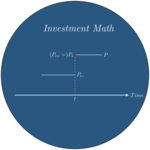Exam (2017)
This is the exam for the 2017 ensae course.
Notations
I consider an investment universe composed of cash (index \(i=0\)) with return \(r\) and \(N\) risky assets (indices \(i=1,\ldots,N\)) with expected returns \(\mu=(\mu_{1},\ldots,\mu_{N})'\) and covariance matrix \(\Sigma\) (dimension \((N,N)\)). Each investor builds a portfolio \(\pi=(\pi_{0},\tilde{\pi})\) where \(\pi_{0}\) is the proportion of wealth invested in cash and \(\tilde{\pi}\) is a vector of size \((N,1)\) recording the proportions invested on the risky assets. The portfolio vector satisfies the following contraint: \[\pi_{0}+\tilde{\pi}'e=1,\] where \(e\) is the vector of size \(N\) with all components equal to \(1\).
Part \(1\)
Exercise 1
Investor preferences are assumed quadratic (expected utility): \[\pi_{0}r+\tilde{\pi}'\mu-\frac{\rho}{2}\tilde{\pi}'\Sigma\tilde{\pi},\] indexed by \(\rho>0\).
Let’s assume investors access risky assets exclusively through a portfolio \(\tilde{\pi}_{e}\) (satisfying \(\tilde{\pi}_{e}'e=1\)), with expected return \(\mu_{e}\) and variance \(\sigma_{e}^{2}\). Let \(\hat{\pi}_{\rho}\) be the proportion of portfolio \(\tilde{\pi}_{e}\) bought by an investor with parameter \(\rho\) (her risky asset portfolio is therefore \(\tilde{\pi}_{\rho}=\hat{\pi}_{\rho}\tilde{\pi}_{e}\)). Compute \(\tilde{\pi}_{\rho}\).
Given the situation described in question 1, all investors hold different proportions of the index \(\tilde{\pi}_{e}\). We are now interested in marginal changes in risky asset positions investors could make to improve their expected utility level. Compute the gradient of expected utility of investor \(\rho\), measured at \(\tilde{\pi}_{\rho}\).
Show that the gradient is independent of \(\rho\), and that component \(i\) is equal to: \[(\mu_{i}-r)-\beta_{i,e}\eta,\] where \(\beta_{i,e}\) is the beta of asset \(i\) with respect to the index (the beta of \(y\) with respect to \(x\) is \(\text{Cov}(y,x)/\text{Var}(x)\)) and \(\eta\) is a constant that will be expressed as a return.
To improve expected utility, one can move positions in the direction given by the gradient. Explain why all investors agree on the assets to buy and sell in this process.
Part \(2\)
In this part, the returns of the assets between date \(t-1\) and date \(t\) will be noted \(R_{i,t}\) while the rates of return are written \(r_{i,t}\). The vector (of size \((N+1,1)\)) of returns is \(R_{t}\). Note that this vector contains the cash return. I assume initially that the sequence of returns is i.i.d.. As usual, the vector of size \((N+1,1)\) with all components equal to \(1\) is noted \(e\).
Let \(w_{t}\) be the level of wealth. At any date \(t<T\), the investor maximizes the expected value of the log of wealth at horizon \(T\).
Exercice 2
Describe the optimization program and define the value function.
Give the dynamic programming equation between date \(t\) and \(t+1\).
Using backward induction, show that the value function has the following structure: \[V_{t}(w_{t})=\log(w_{t})+A_{t},\] where \(A_{t}\) is a constant. Conclude that the investor solves the same optimization problem (which one ?) at each date \(t\).
Give the first order condition of the problem identified in question \(3\). Is this condition sufficient ?
We now assume that there is a solution to the optimization problem identified in question \(3\).
- Assume that an investor with infinite investment horizon solves the sequential optimization problem defined above. This leads to a same optimal portfolio \(\pi_{*}\) being chosen in each period. Prove that this policy beats any other static portfolio choice \(\pi\neq\pi_{*}\).
I now drop the assumption that returns are i.i.d.. The conditional distribution \({\cal L}_{t}(R_{t+1})\) of period \(t+1\) returns as seen from period \(t\) is supposed to be characterized by a markovian state variable \(x_{t}\). More generally, we assume that for any random variable \(y_{t+1}\): \[E_{t}[y_{t+1}]=E[y_{t+1}|x_{t}].\] It is reminded that \(E[y_{t+1}|x_{t}]\) can be written \(g(x_{t})\) where the function \(g(\cdot)\) is specific to the random variable \(y_{t+1}\).
The optimization problem is otherwise unchanged.
Define the state variable of the new problem, and give the new dynamic programming equation.
Show that the value function now has the following structure: \[V_{t}(x_{t},w_{t})=\log(w_{t})+A_{t}(x_{t}).\]
Which optimization problem is solved at each date as a result ? The solution will be noted \(\pi_{t}^{*}(x_{t})\).
I remind that a martingale difference is a process \((z_{t})_{t\in \mathbb{N}}\) satisfying \(E_{t}[z_{t+1}]=0\). We will admit that under some condition on second moments, almost surely: \[\lim_{T \rightarrow +\infty}\frac{1}{T}\sum_{t=1}^{T}z_{t}=0.\]
We now want to extend the result of question \(5\) to the new context. An investor chooses at each date the portfolio \(\pi_{t}(x_{t})\). Show that asymptotically, the wealth process generated by \(\pi_{t}^{*}(x_{t})\) dominates that generated by \(\pi_{t}(x_{t})\).
Extend the above results to the continuous time context, starting with the i.i.d. case.
